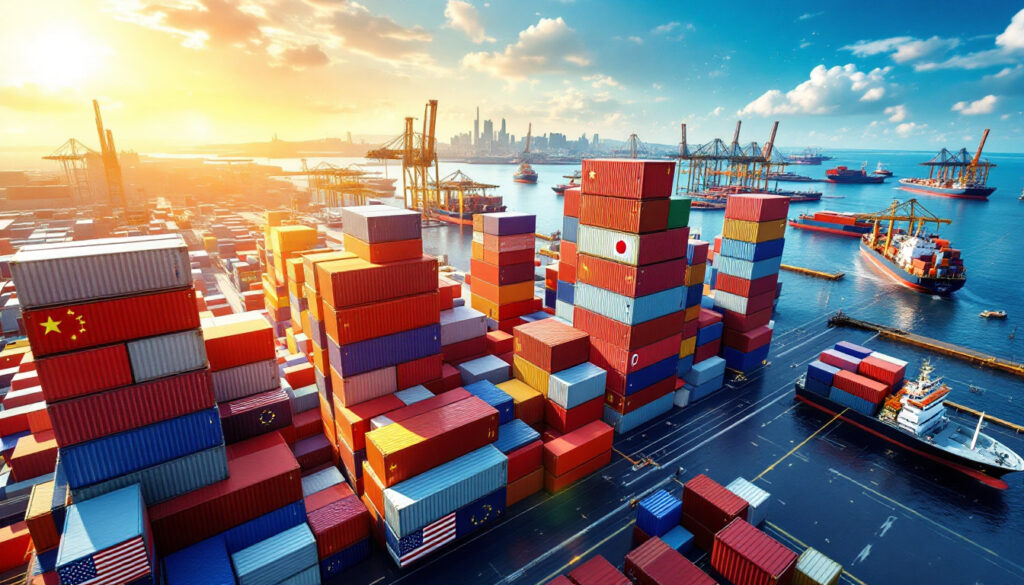Understanding Reciprocal Tariffs and Their Impact on Global Trade
Reciprocal tariffs represent a significant shift in global trade policy, creating ripple effects across international markets and supply chains. These tariffs, designed to match or exceed the import duties imposed by other nations on U.S. goods, mark a fundamental change in how trade relationships are structured and negotiated. Understanding their mechanisms, exemptions, and potential impacts is crucial for businesses, investors, and policymakers navigating this new economic landscape.
What Are Reciprocal Tariffs and How Do They Work?
Reciprocal tariffs operate on a principle of trade equality – imposing duties on foreign goods that match the rates other countries apply to American exports. The policy establishes a baseline 10% universal tariff rate on all imports starting April 5, 2025, with significant variations by country based on their existing trade practices with the United States.
The mechanism calculates country-specific rates by matching partners' existing tariff structures, with a minimum floor of 10%. This creates a sliding scale of tariffs ranging from 24% to 54% depending on the nation of origin. The implementation follows a staggered timeline between April 5-9, 2025, giving markets limited adjustment time.
Most notably, China faces the steepest combined rate of 54%, comprising a 34% reciprocal tariff plus an additional 20% fentanyl-related penalty. Japan (24%) and South Korea (25%) also face substantial rates that could reshape their export strategies to the American market.
According to White House statements, these measures reflect a belief that "short-term pain will be offset by benefits of reshoring manufacturing, tax cuts, and deregulation" – representing a fundamental shift from decades of globalization-focused Trump's trade policy impact on global commodity markets.
The Strategic Exemptions: Which Commodities Escaped the Tariffs?
Despite the broad application of reciprocal tariffs, certain strategic minerals and commodities received exemptions based on their critical importance to U.S. supply chains and national security concerns.
The critical minerals exemption list includes zinc, tin, nickel, graphite, antimony, tungsten, magnesium, cobalt, gallium, germanium, vanadium, and silicon. These materials serve essential functions in high-tech manufacturing, particularly for defense applications and renewable energy technologies. The exemptions recognize America's heavy reliance on imports for these resources, with domestic production often meeting less than 50% of demand for many of these minerals.
Gold bullion and numerous energy sector commodities also escaped tariffs, reflecting their strategic importance to financial markets and energy security. The "Minerals Not Available in the United States" classification provides the regulatory framework for these exemptions, focusing on materials where domestic production capacity falls significantly short of requirements.
Importantly, pre-existing Section 232 tariffs on steel and aluminum (25%) remain in place alongside the new reciprocal duties. According to mineral security experts, these exemptions represent a targeted approach to address global critical mineral shortages for clean energy while maintaining pressure on consumer goods and finished products.
How Are Global Markets Responding to Reciprocal Tariffs?
Global markets reacted swiftly and dramatically to the reciprocal tariff announcement, with the Dow Jones Industrial Average plummeting 1,600 points on April 3, 2025 – one of the largest single-day drops since the 2020 COVID-19 market crash. This immediate response signals significant investor concerns about potential trade disruptions.
Supply chain managers are already reporting diversification efforts, with copper and other metal shipments being rerouted through alternative channels ahead of implementation deadlines. Major corporations face uncertainty regarding capital expenditure plans, with one metals industry executive noting that "tariffs have put expansion plans on hold as we reassess sourcing strategies and production locations."
Market volatility indicators have spiked to levels comparable to major economic crises, reflecting widespread uncertainty about how global commodities market insights and political dynamics will evolve. Financial analysts note particular concern around M&A activity, which has slowed dramatically as valuations become more difficult to establish in an uncertain trade environment.
The comparison to COVID-19 market disruption is particularly telling, with some economists suggesting that tariff-induced supply chain reorganization could have similar, though more gradual, impacts on global production networks and price stability.
Which Countries Face the Highest Tariff Rates?
China bears the heaviest tariff burden under the new policy, facing a 54% combined rate consisting of a 34% reciprocal tariff plus an additional 20% penalty related to fentanyl production and export concerns. This represents the most aggressive U.S. tariff stance toward any major trading partner and substantially exceeds previous trade war levels.
Japan's 24% tariff structure primarily affects its automotive and electronics exports, two sectors where Japanese firms maintain significant U.S. market share. Similarly, South Korea's 25% tariff impact targets its semiconductor, electronics, and automotive industries – all critical components of its export-driven economy.
White House statements indicate that Mexico and Vietnam also face elevated tariff rates specifically designed to limit trade diversion – the practice of rerouting Chinese goods through third countries to avoid duties. As one trade analyst explained, "The Vietnam tariffs specifically target transshipment loopholes that emerged during previous trade tensions."
This graduated tariff structure creates significant incentives for supply chain reorganization, with higher-tariff nations likely to see manufacturing capacity shift to lower-tariff countries or potentially back to the United States.
How Are Nations Responding to U.S. Tariff Policy?
International responses to the reciprocal tariff policy have varied significantly based on economic relationships and political considerations. The European Union and China quickly announced countermeasure plans, with the EU signaling approximately $45 billion in retaliatory tariffs targeting U.S. agricultural exports and aircraft.
Australia has taken a notably different approach, announcing a non-retaliation stance that prioritizes maintaining positive trade relations with the United States while seeking exemptions through diplomatic channels rather than counter-tariffs.
China has launched what analysts describe as a strategic charm offensive with Asian neighbors, accelerating negotiations on the Trilateral Economic Partnership with Japan and South Korea. This initiative appears designed to create alternative trade frameworks that reduce reliance on U.S. markets.
Trade ministers from affected nations have convened emergency meetings at the World Trade Organization, though the effectiveness of WTO dispute resolution mechanisms remains questionable given the organization's ongoing challenges with enforcement against major economies.
What Are China's Potential Retaliation Options?
China possesses several powerful economic levers it could pull in response to reciprocal tariffs, with critical mineral export restrictions and their impact on global trade representing perhaps its most potent option. China controls approximately 80% of global rare earths production and 75% of gallium and germanium supplies – materials essential for technologies ranging from smartphones to missile guidance systems.
This dominance gives Beijing significant leverage, particularly in rare earths elements like neodymium and dysprosium that are crucial for electric vehicle motors and wind turbines. Previous disputes have demonstrated China's willingness to use these resources strategically, as evidenced by its 2010 rare earth embargo against Japan during territorial disputes.
Beyond minerals, China could accelerate shifting trade alliances by deepening economic integration with Belt and Road Initiative partners. This approach would reduce its reliance on U.S. markets while potentially creating new export destinations for goods that once flowed to America.
Another concerning scenario involves material dumping in alternative markets, where Chinese producers could flood third countries with goods at below-market prices to maintain production levels despite U.S. tariffs. This would create secondary disruptions in global markets and potentially trigger additional trade disputes.
How Will Reciprocal Tariffs Affect Specific Industries?
The metals and mining sector faces complex implications from the tariff structure, with exempted minerals potentially seeing increased investment while tariffed metals experience pricing volatility. The ongoing Section 232 investigation into copper imports creates additional uncertainty for an industry already navigating significant transition pressures.
Automotive supply chains face particular disruption given their global integration and just-in-time delivery requirements. With approximately 30% of automotive parts imported from China, manufacturers anticipate significant cost increases and potential production delays as sourcing strategies are recalibrated.
The electric vehicle industry stands at a particular crossroads, with one manufacturer warning that "lithium-ion battery costs could rise 15-20%" under the new tariff regime despite exemptions for some critical minerals. This comes at a critical juncture when EV adoption rates are highly sensitive to purchase price fluctuations.
Critical minerals supply security concerns extend beyond immediate price effects, with strategic planners warning that tariff-induced market distortions could accelerate resource nationalism globally as countries seek to secure supplies of vital materials.
What Are the Long-Term Economic Implications?
Federal Reserve inflation projections suggest tariffs could add approximately 1.2% to year-over-year inflation by Q4 2025, potentially complicating monetary policy at a time when price stability remains a priority. This inflationary pressure would likely emerge unevenly across sectors, with consumer goods and industrial inputs seeing the largest effects.
Recession scenarios have gained increasing attention among economists, with one prominent analyst warning that "tariff-induced recession risk stands at approximately 35%" if retaliatory measures escalate and consumer spending contracts in response to higher prices.
Reshoring manufacturing expectations represent a core rationale for the tariff policy, though cost-benefit analyses suggest mixed outcomes. While some production may return to the United States, the timeline for major infrastructure like semiconductor fabrication facilities extends 3-5 years, creating a significant lag between tariff implementation and potential domestic capacity expansion.
Global growth slowdown predictions have emerged from multiple economic institutions, with forecasts suggesting tariffs could reduce global GDP by 0.5% in the first year of implementation if current announced measures remain in place without further escalation.
How Might Trade Negotiations Evolve?
The potential for bilateral negotiations has emerged as a key focus, with some analysts suggesting sector-specific deals – similar to the proposed "TikTok-for-tariffs" case – could provide templates for resolving aspects of trade disputes outside multilateral frameworks.
The risk of tariff escalation cycles remains significant, particularly as affected countries implement retaliatory measures that trigger counter-responses. According to a recent Reuters analysis, such cycles can persist for years, gradually reshaping trade relationships and supply chains in ways difficult to predict at the outset.
WTO dispute resolution mechanisms have been initiated by multiple countries, though their effectiveness remains uncertain given ongoing challenges with the organization's appellate body and enforcement capabilities against major economies. The invocation of Article XXI (national security exceptions) by the United States creates particular legal complexities for WTO adjudication.
Shifting geopolitical alliances may ultimately prove more consequential than formal trade mechanisms, with regional trade blocks potentially strengthening as alternatives to traditional global trade patterns. Navigating geopolitical investor strategies in this context requires understanding how non-aligned economies may position themselves in this evolving landscape, as detailed in Coface's economic analysis.
FAQs About Reciprocal Tariffs and Global Trade
What is the difference between reciprocal tariffs and Section 232 tariffs?
Reciprocal tariffs match duties imposed by trading partners, while Section 232 tariffs specifically address national security concerns related to imports. The reciprocal approach uses a country's overall tariff treatment of U.S. goods, while Section 232 targets specific sectors like steel, aluminum, and potentially copper.
How might reciprocal tariffs affect consumer prices?
Consumer prices for imported goods will likely increase proportionally to tariff rates, though the impact will vary by product category and substitutability. Essential consumer electronics, apparel, and household goods could see price increases of 10-25% depending on origin country and existing markup structures.
Which industries are most vulnerable to trade retaliation?
Agricultural exports, particularly soybeans, pork, and tree nuts, face high retaliation risk due to their political significance and replaceability in global markets. Commercial aircraft, pharmaceuticals, and high-end machinery also represent potential targets for counter-tariffs from affected nations.
How do reciprocal tariffs compare to previous U.S. trade policies?
The reciprocal approach represents a significant departure from previous policies by establishing a universal minimum rate and systematically matching foreign tariff structures. Unlike previous targeted measures, this comprehensive approach affects virtually all trading partners simultaneously rather than addressing specific trade disputes individually.
What metrics will determine the success or failure of reciprocal tariffs?
Key success metrics include domestic manufacturing employment growth, trade deficit reduction, and reshoring investment levels. However, these must be weighed against potential costs including consumer price increases, retaliatory export losses, and capital market volatility. The full assessment will require several years of data to evaluate structural economic shifts beyond immediate market reactions.
Want to Profit from the Next Major Mineral Discovery?
Take advantage of real-time insights on how tariff-driven market shifts could reveal new mining opportunities by accessing Discovery Alert's proprietary Discovery IQ model, which identifies significant ASX mineral discoveries the moment they're announced. Explore why historic discoveries generate substantial returns by visiting Discovery Alert's dedicated discoveries page and position yourself ahead of market movements.




